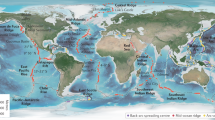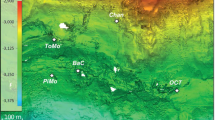Abstract
Hydrothermal fluids circulate through extensive areas of the upper oceanic crust. Most hydrothermal circulation occurs on ridge flanks1,2, where low-temperature fluids flow through porous basalts. These fluids contain variable levels of dissolved organic carbon, but the source and composition of this carbon are uncertain. Here, we report Δ14C and δ13C measurements of dissolved organic carbon in ridge-flank and on-axis hydrothermal fluids sampled from the Juan de Fuca Ridge. Dissolved organic carbon from two independent ridge-flank sites was characterized by low δ13C and Δ14C values. The δ13C values ranged from −26 to −35‰, and were consistent with a chemoautotrophic origin. The 14C ages of the dissolved organic carbon ranged from 11,800 to 14,400 years before present, revealing that the carbon was around three times older than dissolved organics in the deep ocean. The Δ14C values of the ridge-flank dissolved organic matter also corresponded closely to those of dissolved inorganic carbon in the same fluid samples. Taken together, the data suggest that chemosynthetic crustal microbial communities synthesize dissolved organic carbon from inorganic carbon in ridge-flank fluids. We suggest that ridge-flank circulation may support an indigenous biosphere extensive enough to export substantial fixed carbon, with distinct isotopic and probably compositional character, to the overlying ocean.
This is a preview of subscription content, access via your institution
Access options
Subscribe to this journal
Receive 12 print issues and online access
$259.00 per year
only $21.58 per issue
Buy this article
- Purchase on Springer Link
- Instant access to full article PDF
Prices may be subject to local taxes which are calculated during checkout


Similar content being viewed by others
References
Johnson, H. P. & Pruis, M. J. Fluxes of fluid and heat from the oceanic crustal reservoir. Earth Planet. Sci. Lett. 216, 565–574 (2003).
Mottl, M. J. in Energy and Mass Transfer in Marine Hydrothermal Systems (eds Halbach, P. E., Tunnicliff, V. & Hein, J. R.) 271–286 (Dahlem Univ. Press, 2003).
Comita, P. B., Gagosian, R. B. & Williams, P. M. Suspended particulate organic material from hydrothermal vent waters at 21 N. Nature 307, 450–453 (1984).
Hedges, J. I. Global biogeochemical cycles: Progress and problems. Mar. Chem. 39, 67–93 (1992).
Druffel, E. R. M., Williams, P. M., Bauer, J. E. & Ertel, R. Cycling of dissolved and particulate organic matter in the open ocean. J. Geophys. Res. 97, 639–659 (1992).
Lang, S. Q., Butterfield, D. A., Lilley, M. D., Paul Johnson, H. & Hedges, J. I. Dissolved organic carbon in ridge-axis and ridge-flank hydrothermal systems. Geochim. Cosmochim. Acta 70, 3830–3842 (2006).
Walker, B., McCarthy, M. D., Fisher, A. & Guilderson, T. Dissolved inorganic carbon isotopic composition of low-temperature axial and ridge-flank hydrothermal fluids of the Juan de Fuca Ridge. Mar. Chem. 108, 123–136 (2008).
Huber, J. A., Johnson, H. P., Butterfield, D. A. & Baross, J. A. Microbial life in ridge flank crustal fluids. Environ. Microbiol. 8, 88–99 (2006).
Fisher, A. et al. Hydrothermal recharge and discharge across 50 km guided by seamounts on a young ridge flank. Nature 421, 618–620 (2003).
Benner, R., Biddanda, B., Black, B. & McCarthy, M. Abundance, size distribution, and stable carbon and nitrogen isotope compositions of marine organic matter isolated by tangential-flow ultrafiltration. Mar. Chem. 57, 243–263 (1997).
Proskurowskia, G., Lilley, M. D. & Brown, T. A. Isotopic evidence of magmatism and seawater bicarbonate removal at the endeavour hydrothermal system. Earth Planet. Sci. Lett. 225, 53–61 (2004).
Taylor, G. T. et al. Chemoautotrophy in the redox transition zone of the Cariaco Basin: A significant midwater source of organic carbon production. Limnol. Oceanogr. 46, 148–163 (2001).
Hayes, J. M., Strauss, H. & Kaufman, A. J. The abundance of C-13 in marine organic matter and isotopic fractionation in the global biogeochemical cycle of carbon during the past 800 Ma. Chem. Geol. 161, 103–125 (1999).
House, C. H., Schopf, J. W. & Stetter, K. O. Carbon isotopic fractionation by Archaeans and other thermophilic prokaryotes. Org. Geochem. 34, 345–356 (2003).
Cowen, J. P. et al. Fluids from aging ocean crust that support microbial life. Science 299, 120–123 (2003).
Williams, P. M. & Druffel, E. R. M. Radiocarbon in dissolved organic matter in the central North Pacific Ocean. Nature 330, 246–248 (1987).
Loh, A. I., Bauer, J. E. & Druffel, E. R. M. Variable ageing and storage of dissolved organic components in the open ocean. Nature 430, 877–881 (2004).
Guo, L., Santschi, P. H., Cifuentes, L. A., Trumbore, S. E. & Southon, J. Cycling of high-molecular-weight dissolved organic matter in the Middle Atlantic Bight as revealed by carbon isotopic (13C and 14C) signatures. Limnol. Oceanogr. 41, 1242–1252 (1996).
Hernes, P. J. & Benner, R. Transport and diagenesis of dissolved and particulate terrigenous organic matter in the North Pacific Ocean. Deep-Sea Res. I 49, 2119–2132 (2002).
Lilley, M. D. et al. Anomalous CH4 and NH4+ concentrations at an unsedimented mid-ocean-ridge hydrothermal system. Nature 364, 45–47 (1993).
Johnson, H. P. et al. Probing for life in the ocean crust with the LEXEN program. EOS 84, 109–116 (2003).
Keil, R. G., Tsamakis, E., Fuh, C. B., Giddings, J. C. & Hedges, J. I. Mineralogical and textural controls on the organic composition of coastal marine sediments: hydrodynamic separation using SPLITT-fractionation. Geochim. Cosmochim. Acta 58, 879–893 (1994).
Heuer, V. B., Pohlman, J. W., Torres, M. E., Elvert, M. & Hinrichs, K. U. The stable carbon isotope biogeochemistry of acetate and other dissolved carbon species in deep subseafloor sediments at the northern Cascadia Margin. Geochim. Cosmochim. Acta 73, 3323–3336 (2009).
Lang, S. Q., Butterfield, D. A., Schulte, M., Kelley, D. S. & Lilley, M. D. Elevated concentrations of formate, acetate and dissolved organic carbon found at the Lost City hydrothermal field. Geochim. Cosmochim. Acta 74, 941–952 (2010).
D’Hondt, S. et al. Distributions of microbial activities in deep subseafloor sediments. Science 306, 2216–2221 (2004).
McCollom, T. M. & Seewald, J. S. Abiotic synthesis of organic compounds in deep-sea hydrothermal environments. Chem. Rev. 107, 382–401 (2007).
Hernes, P. J. & Benner, R. Photochemical and microbial degradation of dissolved lignin phenols: Implications for the fate of terrigenous dissolved organic matter in marine environments. J. Geophys. Res. 108, 3291 (2003).
Santelli, C. M. et al. Abundance and diversity of microbial life in ocean crust. Nature 453, 653–656 (2008).
Bach, W. & Edwards, K. J. Iron and sulfide oxidation within the basaltic ocean crust: Implications for chemolithoautotrophic microbial biomass production. Geochim. Cosmochim. Acta 67, 3871–3887 (2003).
Beaupré, S. R., Druffel, E. R. M. & Griffin, S. A low-blank photochemical extraction system for concentration and isotopic analyses of marine dissolved organic carbon. Limnol. Oceanogr. Methods 5, 174–184 (2007).
Acknowledgements
The authors gratefully acknowledge the assistance at sea of our co-investigators on the LEXEN project, especially H. Paul Johnson, S. Lang and T. Bjorklund. We also thank A. Fisher and D. Butterfield for comments and insight regarding the JDFR system, and D. Butterfield for sharing inorganic composition data. This work was supported by NSF (LEXEN programme), as well as grants from the University of California Office of the President (CLC programme) and the Packard Foundation.
Author information
Authors and Affiliations
Contributions
M.D.M. planned the project, supervised sampling and analyses, analysed data and wrote the paper; B.D.W. designed and carried out UDOC isolations and sample processing, analysed and plotted data. I.V. designed sampling and ultrafiltration equipment, carried out UDOC isolations and assisted with sample processing. S.R.B. carried out 14C-UDOC sample analyses and analysed data. T.P.G. and E.R.M.D. supervised 14C sample analyses and interpreted data.
Corresponding author
Ethics declarations
Competing interests
The authors declare no competing financial interests.
Supplementary information
Supplementary Information
Supplementary Information (PDF 428 kb)
Rights and permissions
About this article
Cite this article
McCarthy, M., Beaupré, S., Walker, B. et al. Chemosynthetic origin of 14C-depleted dissolved organic matter in a ridge-flank hydrothermal system. Nature Geosci 4, 32–36 (2011). https://doi.org/10.1038/ngeo1015
Received:
Accepted:
Published:
Issue Date:
DOI: https://doi.org/10.1038/ngeo1015
This article is cited by
-
Source rock potential assessment of the Huai Hin Lat Formation, Sap Phlu Basin, Nakhon Ratchasima Province, northeastern Thailand
Acta Geochimica (2023)
-
Diversity of magmatism, hydrothermal processes and microbial interactions at mid-ocean ridges
Nature Reviews Earth & Environment (2022)
-
The black carbon cycle and its role in the Earth system
Nature Reviews Earth & Environment (2022)
-
Enigmatic persistence of dissolved organic matter in the ocean
Nature Reviews Earth & Environment (2021)
-
Abiotic synthesis of graphite in hydrothermal vents
Nature Communications (2019)



